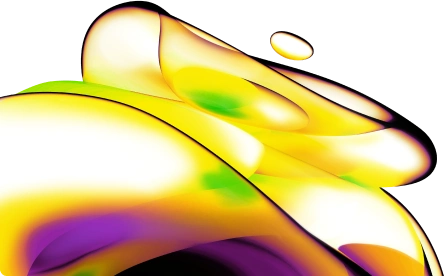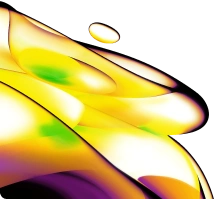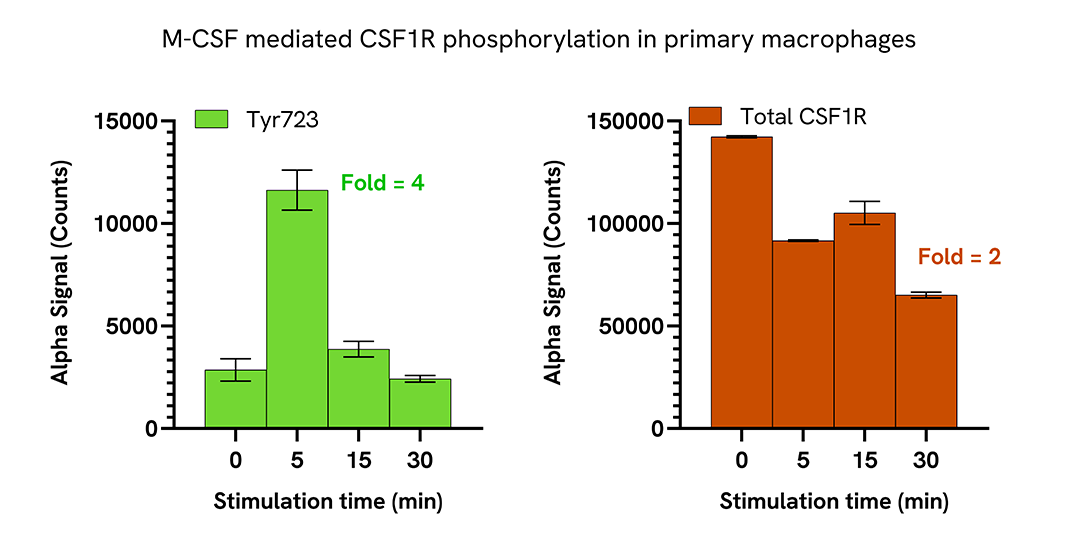

AlphaLISA SureFire Ultra Human Phospho-CSF1R (Tyr723) Detection Kit, 50,000 Assay Points
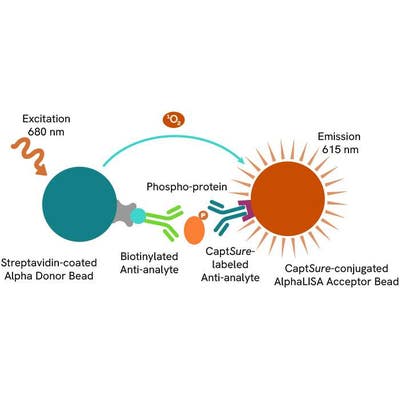
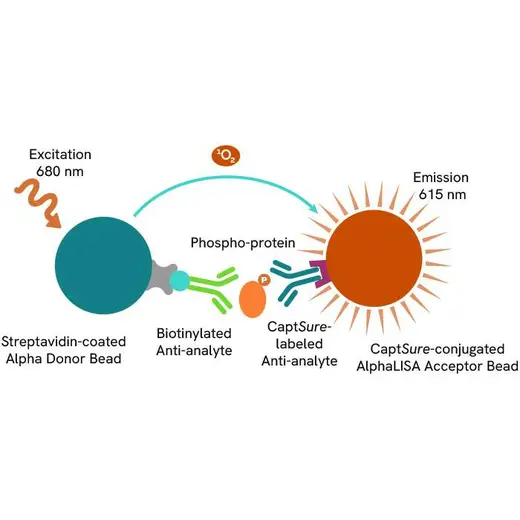
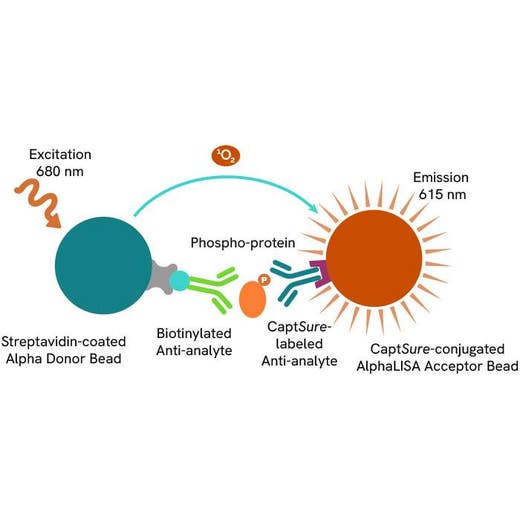
| Feature | Specification |
|---|---|
| Application | 細胞シグナル伝達 |
| Protocol Time | 2h at RT |
| Sample Volume | 10 µL |



Product information
Overview
Colony Stimulating Factor 1 Receptor (CSF1R) is a receptor tyrosine kinase primarily expressed on monocytes, macrophages, and microglia. It binds two primary ligands CSF1 (M-CSF) and IL-34, promoting survival, proliferation, and differentiation of these immune cells. CSF1R signaling is essential for tissue homeostasis, inflammation, and innate immune responses. Aberrant CSF1R activity is associated with cancer progression, immune evasion, and neurodegenerative disorders. In oncology, CSF1R inhibitors aim to reprogram tumor-associated macrophages (TAMs) and enhance anti-tumor immunity. In the CNS, CSF1R is a therapeutic target in diseases like Alzheimer's and ALS due to its role in microglial activation and neuroinflammation.
The AlphaLISA SureFire Ultra Human Phospho-CSF1R (Tyr723) Detection Kit is a sandwich immunoassay for the quantitative detection of phospho-CSF1R (Tyr723) in cellular lysates, using Alpha Technology.
Formats:
- The HV (high volume) kit contains reagents to run 100 wells in 96-well format, using a 60 μL reaction volume.
- The 500-point kit contains enough reagents to run 500 wells in 384-well format, using a 20 μL reaction volume.
- The 10,000-point kit contains enough reagents to run 10,000 wells in 384-well format, using a 20 μL reaction volume.
- The 50,000-point kit contains enough reagents to run 50,000 wells in 384-well format, using a 20 μL reaction volume.
AlphaLISA SureFire Ultra kits are compatible with:
- Cell and tissue lysates
- Antibody modulators
- Biotherapeutic antibodies
AlphaLISA SureFire Ultra kits can be used for:
- Cellular kinase assays
- Receptor activation studies
- High-throughput screening for preclinical studies
How it works
Phospho-AlphaLISA SureFire Ultra assay principle
The Phospho-AlphaLISA SureFire Ultra assay measures a protein target when phosphorylated at a specific residue.
The assay uses two antibodies which recognize the phospho epitope and a distal epitope on the targeted protein. AlphaLISA assays require two bead types: Acceptor and Donor beads. Acceptor beads are coated with a proprietary CaptSure™ agent to specifically immobilize the assay specific antibody, labeled with a CaptSure tag. Donor beads are coated with streptavidin to capture one of the detection antibodies, which is biotinylated. In the presence of phosphorylated protein, the two antibodies bring the Donor and Acceptor beads in close proximity whereby the singlet oxygen transfers energy to excite the Acceptor bead, allowing the generation of a luminescent Alpha signal. The amount of light emission is directly proportional to the quantity of phosphoprotein present in the sample.
Phospho-AlphaLISA SureFire Ultra two-plate assay protocol
The two-plate protocol involves culturing and treating the cells in a 96-well plate before lysis, then transferring lysates into a 384-well OptiPlate™ plate before the addition of Phospho-AlphaLISA SureFire Ultra detection reagents. This protocol permits the cells viability and confluence to be monitored. In addition, lysates from a single well can be used to measure multiple targets.
Phospho-AlphaLISA SureFire Ultra one-plate assay protocol
Detection of Phosphorylated target protein with AlphaLISA SureFire Ultra reagents can be performed in a single plate used for culturing, treatment, and lysis. No washing steps are required. This HTS designed protocol allows for miniaturization while maintaining AlphaLISA SureFire Ultra quality.
Assay validation
Induction of CSF1R phosphorylation in various cell types
PBMCs were isolated from healthy donors and cultured for 7 days in complete DMEM containing 20 ng/mL M-CSF to differentiate them into macrophages. Macrophages were seeded in a 96-well plate (40,000 cells/well) in complete DMEM, and incubated overnight at 37°C, 5% CO2. The cells were starved for 2 hours in HBSS + 0.1% BSA and then treated with 100 ng/mL M-CSF for the indicated time points.
After treatment cells were lysed with 100 µL of Lysis Buffer for 10 minutes at RT with shaking (350 rpm). CSF1R Phospho (Tyr723) and Total levels were evaluated using respective AlphaLISA SureFire Ultra assays. For the detection step, 10 µL of cell lysate (approximately 4,000 cells) was transferred into a 384-well white OptiPlate, followed by 5 µL of Acceptor mix and incubated for 1 hour at RT. Finally, 5 µL of Donor mix was then added to each well and incubated for 1 hour at RT in the dark. The plate was read on an Envision using standard AlphaLISA settings.
M-CSF triggered a rapid phosphorylation of Tyr723, peaking at 5 minutes and then decreasing thereafter. Total CSF1R levels decreased around 50% at 30 minutes, suggesting degradation occurs post phosphorylation.

THP-1 cells were seeded in a 96-well plate (200,000 cells/well) in HBSS + 0.1% BSA and starved for 2 hours at 37°C, 5% CO2. The cells were treated with 100 ng/mL M-CSF for the indicated time points.
After treatment, the cells were spun down and lysed with 100 µL of Lysis Buffer for 10 minutes at RT with shaking (350 rpm). CSF1R Phospho (Tyr723) and Total levels were evaluated using respective AlphaLISA SureFire Ultra assays. For the detection step, 10 µL of cell lysate (approximately 20,000 cells) was transferred into a 384-well white OptiPlate, followed by 5 µL of Acceptor mix and incubated for 1 hour at RT. Finally, 5 µL of Donor mix was then added to each well and incubated for 1 hour at RT in the dark. The plate was read on an Envision using standard AlphaLISA settings.
As expected, M-CSF triggered a rapid phosphorylation of Tyr723 while Total CSF1R levels decreased 2-fold at 30 minutes.
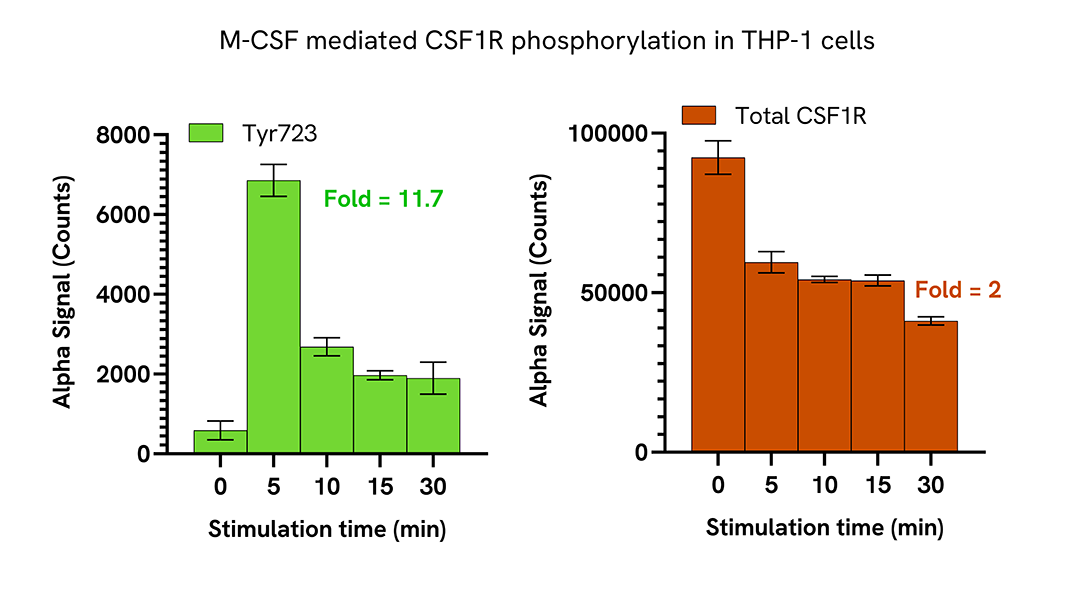
BeWo cells were seeded in a 96-well plate (60,000 cells/well) and incubated overnight at 37°C, 5% CO2. The cells were starved for 2 hours in HBSS + 0.1% BSA and then treated with 100 ng/mL M-CSF for the indicated time points.
After treatment, the cells were lysed with 100 µL of Lysis Buffer for 10 minutes at RT with shaking (350 rpm). CSF1R Phospho (Tyr723) and Total levels were evaluated using respective AlphaLISA SureFire Ultra assays. For the detection step, 10 µL of cell lysate (approximately 6,000 cells) was transferred into a 384-well white OptiPlate, followed by 5 µL of Acceptor mix and incubated for 1 hour at RT. Finally, 5 µL of Donor mix was then added to each well and incubated for 1 hour at RT in the dark. The plate was read on an Envision using standard AlphaLISA settings.
As expected, M-CSF triggered a rapid phosphorylation of Tyr723 while Total CSF1R levels decreased 2-fold at 30 minutes.
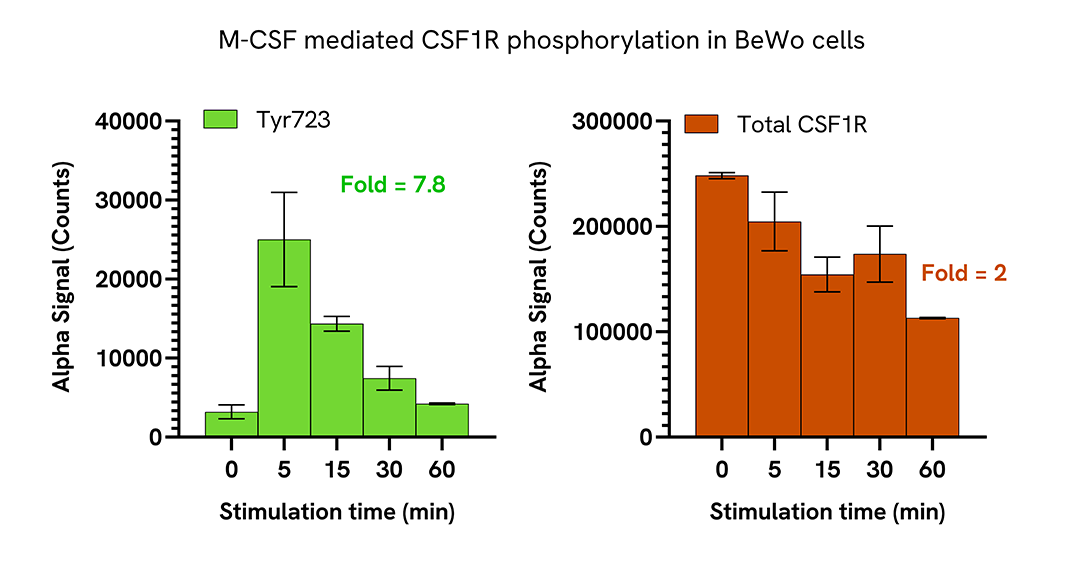
M-CSF induces CSF1R phosphorylation in a dose-dependent manner
THP-1 cells were seeded in a 96-well plate (200,000 cells/well) in HBSS + 0.1% BSA and starved for 2 hours at 37°C, 5% CO2. The cells were treated with increasing concentrations of M-CSF for 5 minutes.
After treatment, the cells were spun down and lysed with 100 µL of Lysis Buffer for 10 minutes at RT with shaking (350 rpm). CSF1R Phospho (Tyr723) and Total levels were evaluated using respective AlphaLISA SureFire Ultra assays. For the detection step, 10 µL of cell lysate (approximately 20,000 cells) was transferred into a 384-well white OptiPlate, followed by 5 µL of Acceptor mix and incubated for 1 hour at RT. Finally, 5 µL of Donor mix was then added to each well and incubated for 1 hour at RT in the dark. The plate was read on an Envision using standard AlphaLISA settings.
As expected, M-CSF triggered a dose-dependent increase in the levels of Phospho CSF1R (Tyr723) while Total CSF1R remained unchanged.
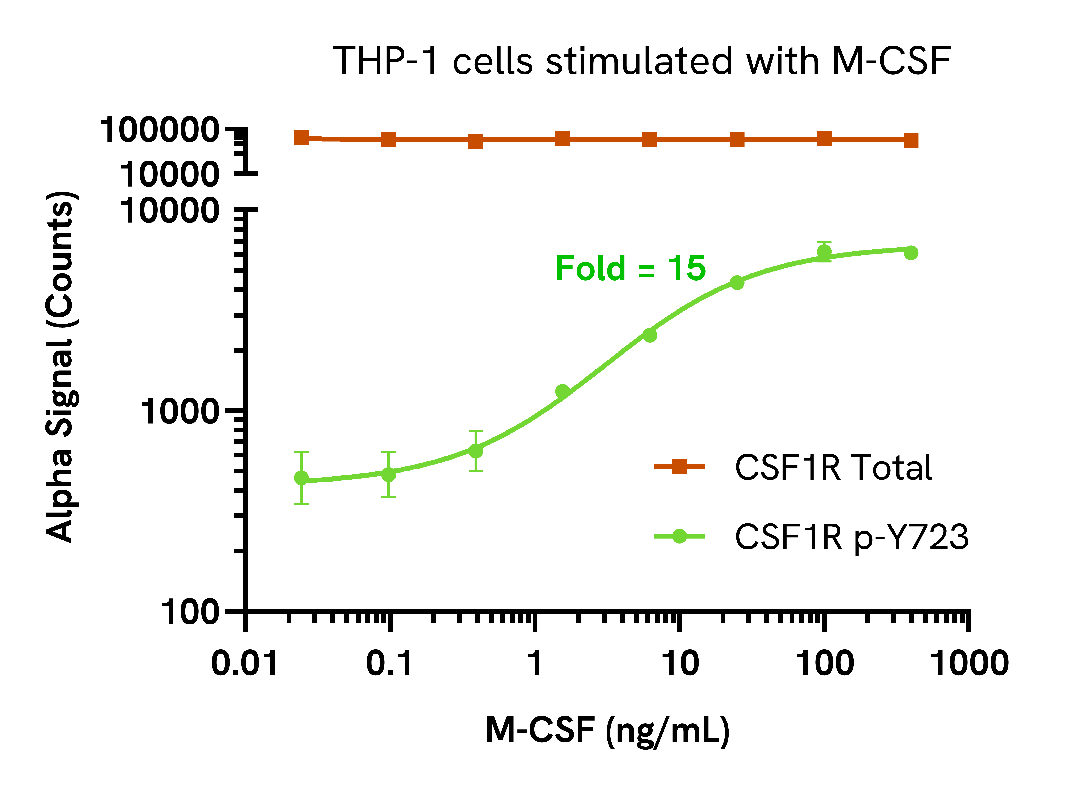
BeWo cells were seeded in a 96-well plate (60,000 cells/well) and incubated overnight at 37°C, 5% CO2. The cells were starved for 2 hours in HBSS + 0.1% BSA and then treated with increasing concentrations of M-CSF for 5 minutes.
After treatment, the cells were lysed with 100 µL of Lysis Buffer for 10 minutes at RT with shaking (350 rpm). CSF1R Phospho (Tyr723) and Total levels were evaluated using respective AlphaLISA SureFire Ultra assays. For the detection step, 10 µL of cell lysate (approximately 6,000 cells) was transferred into a 384-well white OptiPlate, followed by 5 µL of Acceptor mix and incubated for 1 hour at RT. Finally, 5 µL of Donor mix was then added to each well and incubated for 1 hour at RT in the dark. The plate was read on an Envision using standard AlphaLISA settings.
As expected, M-CSF triggered a dose-dependent increase in the levels of Phospho CSF1R (Tyr723) while Total CSF1R remained unchanged.
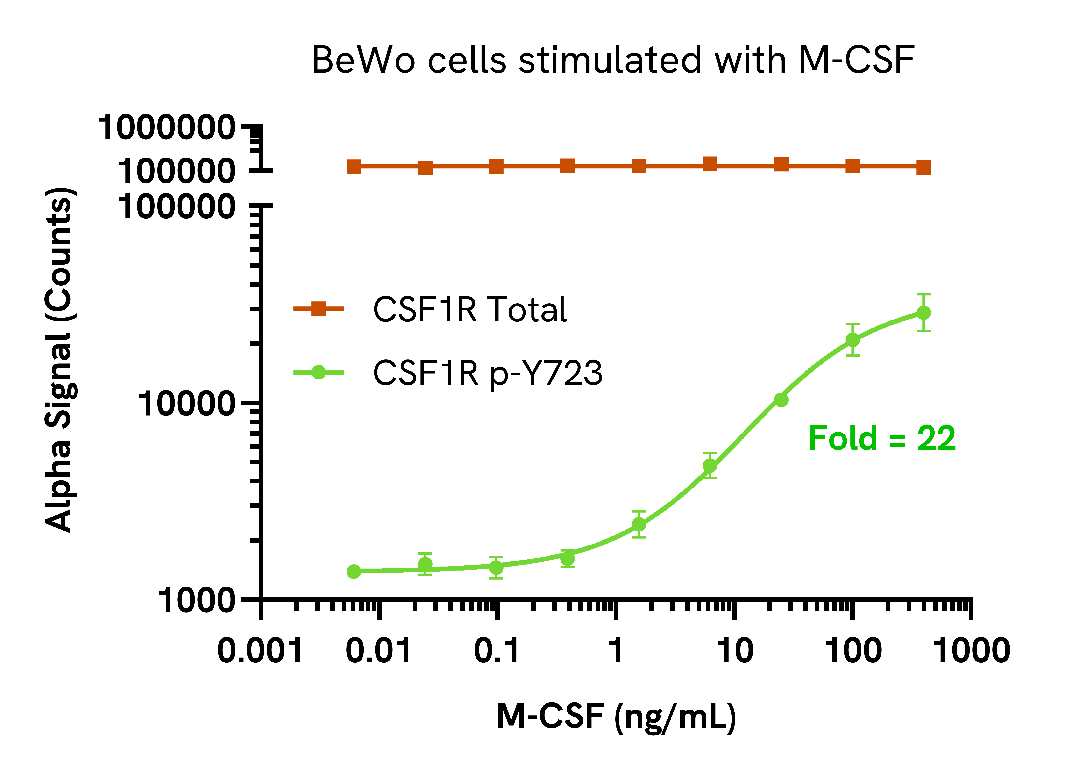
IL-34 induces CSF1R phosphorylation in a dose-dependent manner
THP-1 cells were seeded in a 96-well plate (200,000 cells/well) in HBSS + 0.1% BSA and starved for 2 hours at 37°C, 5% CO2. The cells were treated with the indicated concentrations of IL-34 for 5 minutes.
After treatment, the cells were spun down and lysed with 100 µL of Lysis Buffer for 10 minutes at RT with shaking (350 rpm). CSF1R Phospho (Tyr723) and Total levels were evaluated using respective AlphaLISA SureFire Ultra assays. For the detection step, 10 µL of cell lysate (approximately 20,000 cells) was transferred into a 384-well white OptiPlate, followed by 5 µL of Acceptor mix and incubated for 1 hour at RT. Finally, 5 µL of Donor mix was then added to each well and incubated for 1 hour at RT in the dark. The plate was read on an Envision using standard AlphaLISA settings.
As expected, IL-34 triggered a dose-dependent increase in the levels of Phospho CSF1R (Tyr723).
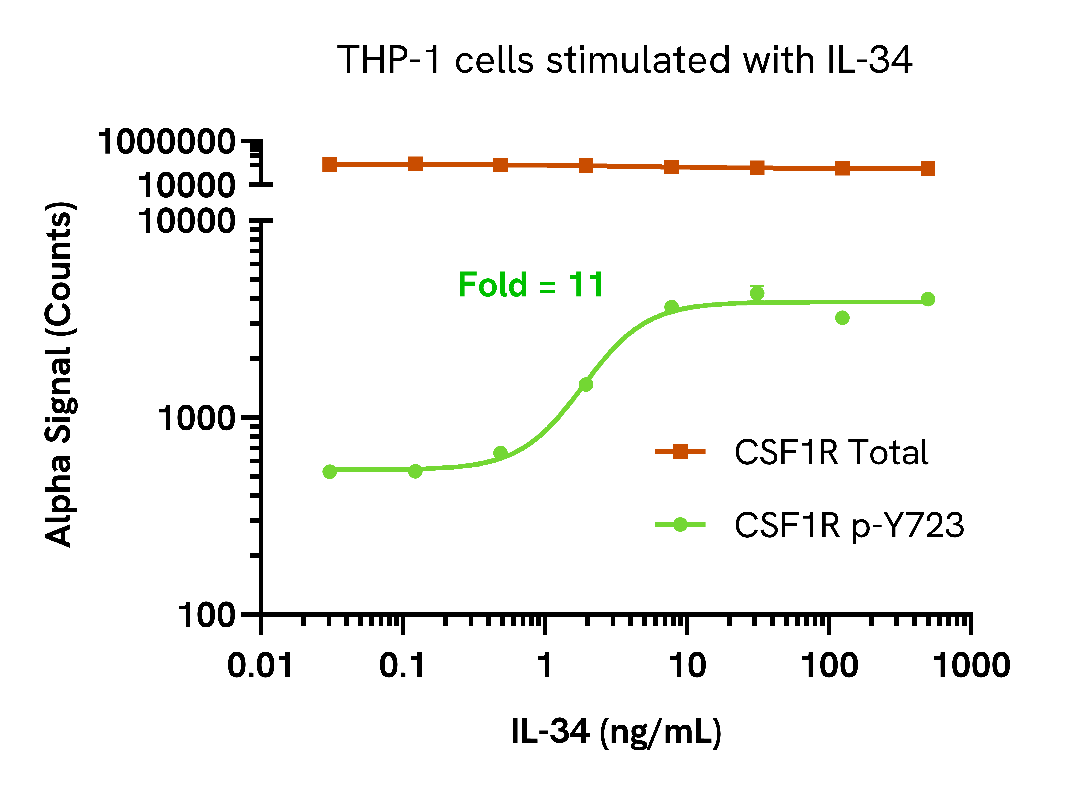
Specifications
| Application |
Cell Signaling
|
|---|---|
| Automation Compatible |
Yes
|
| Brand |
AlphaLISA SureFire Ultra
|
| Detection Modality |
Alpha
|
| Product Group |
Kit
|
| Protocol Time |
2h at RT
|
| Sample Volume |
10 µL
|
| Shipping Conditions |
Shipped in Blue Ice
|
| Target |
CSF1R
|
| Target Class |
Phosphoproteins
|
| Target Species |
Human
|
| Technology |
Alpha
|
| Therapeutic Area |
Neuroscience
Oncology
|
| Unit Size |
50,000 assay points
|
Resources
Are you looking for resources, click on the resource type to explore further.
Alpha technolgy enables the rapid and straightforward mesaure of virtually any target. This includes enzymes, receptor-ligand...
The definitive guide for setting up a successful AlphaLISA SureFire Ultra assay
Several biological processes are regulated by...
Discover Alpha SureFire® Ultra™ assays, the no-wash cellular kinase assays leveraging Revvity's exclusive bead-based technology...
This document includes detailed tables listing HTRF™, AlphaLISA™ SureFire® Ultra™, and Alpha SureFire® Ultra™ Multiplex assays...


How can we help you?
We are here to answer your questions.
